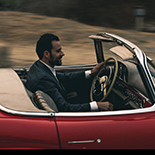By Nicolas Zart of Car News Cafe
The name alone strikes the imagination. Ferrari Testarossa! Three different cars held that name. Three different generations, each with their particularities would closely associate the name Testarossa with Ferrari.
Ferrari Testarossa 1, 2 and 3
Three Ferrari held the mythical name Testarossa. The 1957 “Testa Rossa” that ran in the World Sportscar Championship, as well as the 24 Hours of Le Mans and the early 1960s, which was also raced globally. But the one we will talk about today wasn’t officially raced. However, it was one of Ferrari’s most successful road car, after the company decided to clearly make a difference between its race and road cars in the 1970s. This Ferrari was also pole vaulted to fame through the lens of yet another TV series, Miami Vice.
What’s in a Ferrari Testarossa? The term itself is Italian for red head, which was the moniker given to the original 1950s Testarossa when it appeared with red painted cam covers. And a fiery red headed car it was. But the mid-1980s last Testarossa was a completely different beast and shared no common parts even with its 1950s or 1960s counterpart. This one sported a flat 12 cylinder in mid-central position, which kept its center of gravity towards the middle of the car and low. This gave the Testarossa great cornering capability and one of Ferrari’s most produced after it was introduction at the 1984 Paris Auto Show.
Ferrari Testarossa Swoops, Ducts And Wide Eyed.
The 1984 Ferrari Testarossa definitely impressed many from the get go. It’s dramatic design was both bold and striking. What many didn’t appreciate at the time was that the incredible work Pininfarina put into the design made this car an impressively aerodynamic car, amongst a few things.
The strict two-door coupe was well designed, to say the least. It sported a wonderful 40% front to 60% rear weight distribution and was consequently re-engineered in 1992 as a TR with a slightly better distribution weight of 41% to 59% in the rear. It later reappeared in 1994 as the F512 M, M for modificata, modified in Italian with 42% and 58% rear distribution, little changed in the overall design.
Ferrari Testarossa, Technically Speaking.
The Ferrari Testarossa can be traced back to the introduction of the 512i BB in 1981, alias Boxer. The Boxer was a hot car, in more ways than one, which was one of the characteristic the Testarossa was to fix. After all, it isn’t easy fitting a voracious 4.9-liter, 4,943 cc, flat-12 in car without over heating in Los Angeles traffic. With four valves, 48 in total, lubrication happened with a dry sump, and the compression ratio was 9.20:1. The torquey engine developed 361 ft-lb at a low 4500 rpm with a maximum of 380 HP at 6300 rpm in the U.S.. The TR improved those numbers with a 10.00:1 compression, a maximum torque of 362 ftlb at 5500 rpm, and 428 hp at 6750 rpm.
Truly the car shined in comparison road tests back then. Although the weight distribution certainly helped, another lesser-known aspect was its aerodynamic design, which although very audacious, served a very concrete reason.
Ferrari Testarossa’s Practical Swooping Air Ducts
If you close your eyes and recall the Ferrari Testarossa of the mid-80s, I bet one of the first thing that will jump to you are its dramatic air duct scoops that stretched from the door, wrapping around the tail of the car. Most believe it to be a design cue, but not too many understood it’s aerodynamic value. Those air scoops allowed the Ferrari Testarossa to achieve great downforce without reverting to a back spoiler.
In order to do this, Pininfarina called upon Ian Cameron, Guido Campoli, Diego Ottina, Emanuele Nicosia, who were led by design chief Leonardo Fioravanti. Fioravanti was a trained aerodynamist who managed to achieve a drag coefficient of 0.36 on the Testarossa. By forcing cool air from the side into the radiators, it was then pushed upward and around the car where it escaped through the engine lid and tail. Not only did this mean that the Testarossa had no use for a rear spoiler, but kept the cabin cooler, something the 512 BBi Boxer couldn’t do well.
Pininfarina’s stretched side strakes served more than an aerodynamic purpose as well. They were needed in order to meet certain countries security demands around large openings on cars. The Testarossa couldn’t have race inspired scoops opening to the side and therefore relied on these often time called cheese graters or egg slicers, in order to host the twin rear radiators and the single front one.
Wide Eyed, Wide Body Ferrari Testarossa For Better Handling.
Another notable difference between the 512 Bbi Boxer and the Testarossa was that the latter was much wider. These dramatic side vents meant that the Testarossa rested on a wider chassis, sitting on a double wishbone front and rear suspensions. Resting on 10-inch-wide alloy rear wheels, which was very big at the time, the wheel sported a a hefty 16.33 inch diameter magnesium single bolt “knockoff”. The car used Michelin TRX tires with an odd diameter that made it impossible to use standart different tires. The Testarossa used 240/45 VR 415 front and TRX 280/45 VR 415 rear Michelin TRX tires. 78 wider then its predecessor Boxer, it was half a foot wider and made for even better cornering.
Finally the dramatic Pininfarina design not only improved aerodynamics and handling, but it also improved the niceties one would expect from a car that eventually cost $220,000 with the F512 M. The increased wheelbase could now accommodate luggage in a front luxurious carpeted frunk.
Introducing the Beverly Hills Car Club Ferrari Testarossa!
The Beverly Hills Car Club is truly excited to announce the availability of two of these iconic Ferrari Testarossas, the soon to be announced 1987 Ferrari Testarossa, stock # 06527 and the already available 1988 Ferrari Testarossa stock # 06076.
Lot number # 06527 only has 3,874 on the odometer and is robed in its stunning rossa corsa with tan interior and a salvage title. It is a very clean and presentable car that will need some servicing, but that is otherwise an excellent investment. It will soon be made available for $108,500.
Lot number # 06076 only has 66,041 on the odometer and is robed in Ferrari’s elegant blanco with tan interior. A very presentable car in a great color combination, it received a recent major service totaling close to $20,000. It also comes with the original window sticker, service records, owners manual and warranty and maintenance booklet for $82,500.
Now let me go back to watching Miami Vice as I rediscover the Ferrari Testarossa the Beverly Hills Car Club offers in its originality.







